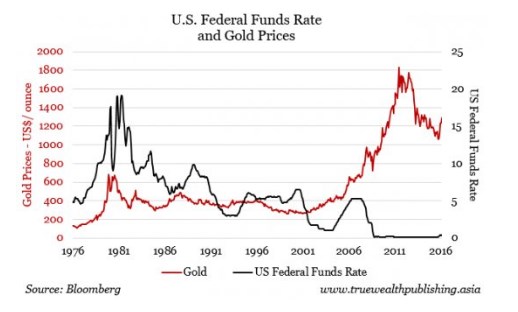
10 Aug The price of gold and the Federal Reserve
Photo: markgraf/morguefile.comQ. I hear the price of gold is expected to go higher. What do the Fed’s decisions mean for gold?
— Trying to understand
A. Time to get a little technical.
The Federal Reserve Bank controls the Federal Funds Rate, which is the rate at which depository institutions — banks and credit unions — lend reserve balances to other depository institutions overnight, said Taylor Thomas, a certified financial planner with Round Table Wealth Management in Westfield.
Looking back in history, there has been little correlation between the rate movements — either up or down — of the Federal Funds Rate and the price of gold, Thomas said. Correlation is a measurement of how two investment values move in relation to one another.
He said investments can move with positive correlation, when one goes up the other goes up or negative correlation, when one goes down the other one goes up.
Looking back over the past 36 years of history between the price of gold and the Federal Funds Rate, the correlation between these two have been -0.04. A correlation rating of 0 would mean there is no correlation, he said.
“Basically, there has been no correlation between gold and the Federal Funds Rate over the long-term,” Thomas said. “During shorter time periods, gold and the Federal Funds Rate can experience increased correlation.”
Taylor offers this chart from Bloomberg, which plots the price of gold and the Federal Funds Rate from 1976 through 2016.

He said the chart shows seven times when there have been significant periods of interest rate hikes. During those periods, the price of gold has stayed about the same, gone up and gone down, he said.
If an investor is trying to put a fair value on the price of gold or thinking of whether to buy gold, Taylor says you should consider these points:
First, gold is considered a “safe haven” asset and can experience an increase in value during times of stock market volatility or economic and political instability, Taylor said.
Second, unlike stocks and bonds, gold does not provide an investor with any form of yield, he said.
“A gold investor will only benefit if the value of gold appreciates,” Taylor said. “During a rising interest rate environment, investors may decide to move funds from gold and other `safe haven’ assets into investments which now provide a higher yield and may offer less risk of principal loss, like a bond held until maturity.”
Third, Taylor said, the strength or weakness of the U.S. dollar should also be taken into consideration.
“Looking back over the past 40 years, gold and the value of the U.S. dollar have had a strong negative correlation of about -.40,” he said. “This means that as the value of the dollar increases, the value of gold decreases.”
Given that the U.S. is currently in rising interest rate environment and the value of the dollar is usually positively correlated to interest rates, we may see the value of gold decline over the next few years, Taylor said. He said the analysis excludes other factors such as trade deficits and surpluses, stock market valuations, economic growth, inflation and other factors that affect the value of the dollar.
“The value of gold tends to be speculative and rise in periods of significant economic and geopolitical uncertainty and it is difficult to discern the direction of gold based on only one factor, a rise in the Fed Funds rate, because the price can be affected by many different issues,” Taylor said.
Email your questions to Ask@NJMoneyHelp.com.
This post was first published in August 2016.
NJMoneyHelp.com presents certain general financial planning principles and advice, but should never be viewed as a substitute for obtaining advice from a personal professional advisor who understands your unique individual circumstances.
